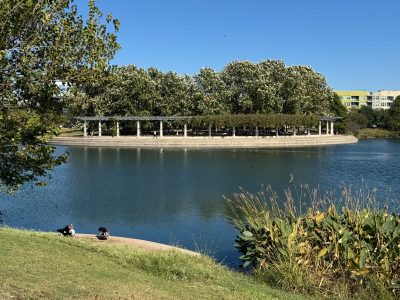The Visionary Behind Mueller’s Transformation
If you love Mueller’s parks as much as I do, you’re going to be excited about this one – Lake Park is officially getting a name, which means we have a brand-new installment in our People Behind the Parks series. And today, we’re highlighting someone whose fingerprints are all over Mueller’s past, present, and future: architect and community advocate, Girard Kinney.
Few people have shaped this community more deeply – and often more quietly – than Girard. His story is uniquely Austin, rooted in creativity, persistence, and a belief that neighborhoods should be designed for people first.
A Childhood Rooted in Austin History
Girard Kinney was born in 1943 at Walter Reed Hospital, but Austin became home almost immediately. His family settled in the Zilker neighborhood, in a historic home built by his grandfather’s great uncle in 1873 – long before Zilker had the identity it has today.
Before architecture entered the picture, Girard was obsessed with herpetology. Yes, he collected and even milked snakes to sell venom to the U.S. Navy for anti-venom research. Only in Austin, right?
But a teacher’s question about careers – coupled with his strengths in math and art – nudged him toward architecture, and the rest is history.
Finding His Voice Through Architecture
Girard enrolled at the University of Texas School of Architecture in 1961, studying under respected professors including Alan Taniguchi (whose father inspired the name of Mueller’s own Isamu Taniguchi Park).
Like many UT students, he juggled several jobs to get through school. Unlike most students, his jobs were wildly eclectic – license clerk at the Texas Game & Fish Commission, draftsman at Calcasieu Lumber Company, and manager of a model car racing track.
After temporarily leaving UT in protest of the university’s stance on the Vietnam War and a plan to remove mature live oaks, Girard returned in 1978 to finish his last course and officially graduate.
An Architect Who Helped Define Austin
Throughout his long career, Girard has shaped some of Austin’s most beloved spaces:
- Symphony Square along Waller Creek
- The Whisenhunt theater-in-the-round at Zach Scott Theatre
- The Pfluger Pedestrian Bridge across Lady Bird Lake
- Austin’s Great Streets Program, created with Sinclair Black
These projects all share one thing: they prioritize people, community, and connection – values that show up in Mueller’s design as well.

The Heart of the Mueller Redevelopment
When Girard and his family moved to Cherrywood in 1983, they landed just south of the old Robert Mueller Municipal Airport. That proximity sparked a decades-long passion.
As the airport’s expansion became a growing concern, Girard co-led Citizens for Airport Relocation (CARE), pushing not only for a new airport site but for the opportunity to reimagine what the existing 700+ acres could become.
He later served:
- 10 years on Austin’s Airport Advisory Board
- As the first chair of the Mueller Commission
- As a consultant for the redevelopment team, evaluating feasibility for the Browning Hangar and public access to the historic control tower
If you’ve ever walked the Browning Hangar, biked under the shade of new trees, or enjoyed one of Mueller’s parks – Girard played a part in making that possible.
A Lasting Legacy in Austin’s Built Environment
Beyond Mueller, Girard has served on numerous boards, including:
- The American Institute of Architects (Austin Chapter)
- The City of Austin’s History Center
- The City of Austin Design Commission
He also founded the Cherrywood Neighborhood Association and the Austin chapter of Scenic America, focusing on roadway beautification and community-focused planning.
Simply put: Austin looks the way it does in part because Girard cared enough to shape it – thoughtfully, relentlessly, and always with the community in mind.
More People Behind the Parks of Mueller
Each of these remarkable individuals helped shape Austin into the community we love today – and their legacies continue to inspire how we live, connect, and grow here in Mueller.

